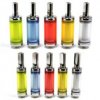Here's a very comprehensive list.
http://www.e-cigarette-forum.com/fo...s-crack-tanks-ce2s-clearos-2.html#post4115601
No clue why some people have issues and other's don't.

I vape a lot of citrus and never had issues. Other's have.
**Scroll through that thread, it's been updated many times.
Thanks for supplying the link, Caridwen. The most up-to-date list is here:
http://www.e-cigarette-forum.com/fo...-crack-tanks-ce2s-clearos-33.html#post8158663
The plastic that is in question is
polycarbonate. It is found in nearly all of the clearomizers and the older, cheaper cartomizer tanks that have a
clear plastic tube. When in contact with certain chemicals, it undergoes a physical breakdown of its structure causing it to crack, slowly leach chemicals into the juice, or actually melt within minutes.
My first and only experience witnessing this was after filling a clearomizer with some new strawberry lemonade. Within 5 minutes the clearomizer had literally melted in my hands. From that point on, I used only juice delivery devices that use the frosted polypropylene plastic, pyrex glass, or stainless steel tanks. And since the metal cartomizers use no polycarbonate, they are safe to use with these flavors, too.
These so-called clearo-killers or tank-cracker juices are not harmful to vape, despite people's ignorance to the contrary. It is simply a chemical reaction between a specific plastic and the ingredients used in some juice flavors.
I'm quite certain everyone has had a Coke. Well, what is the most often used solvent to dissolve the crud off of a battery terminal. You guessed it. Just because soda reacts with the crud on a battery terminal does not mean it is doing the same to your stomach.
The plastic polypropylene is safe to use with the volatile flavors. You can visually determine if the tube material is polypropylene by observing if it has a frosted, not clear, appearance.

Polypropylene dct tanks. Note the frosted appearance of the tubes.
Edit: Just an added note. Even the more expensive cartotanks are still being sold with polycarbonate tubes. Just because a device is expensive, don't assume that the manufacturer is using the better material of pyrex glass tubes.

 I vape a lot of citrus and never had issues. Other's have.
I vape a lot of citrus and never had issues. Other's have.